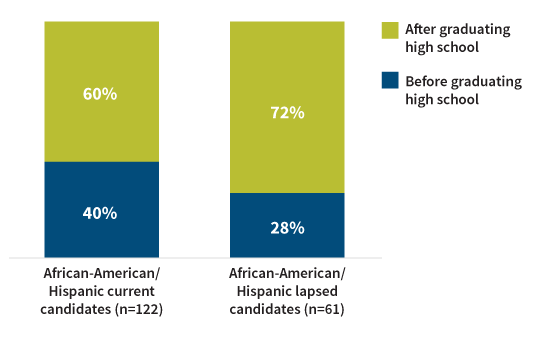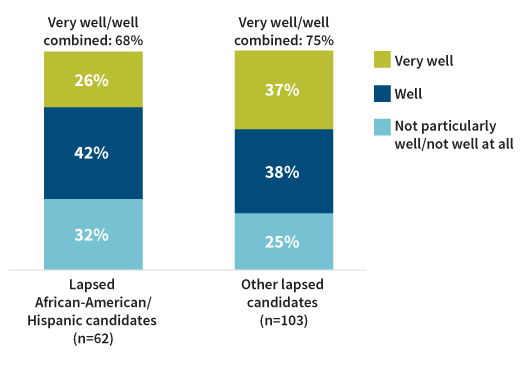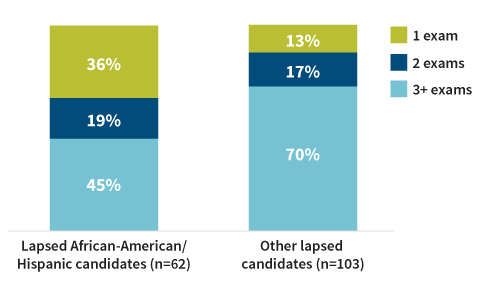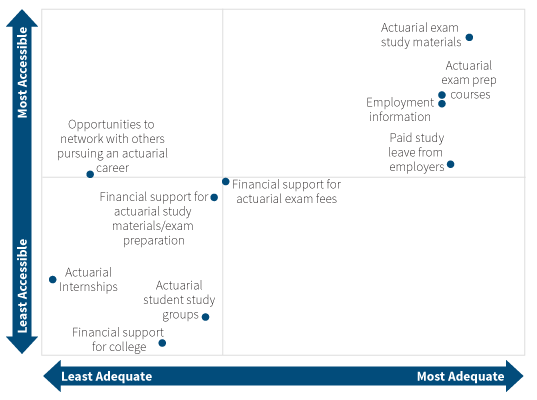New Report Holds Keys to Diversity and Inclusion
Five barriers revealed
March 2018 Web ExclusiveIn a new study conducted on behalf of the Society of Actuaries (SOA), The Actuarial Foundation, the Casualty Actuarial Society (CAS) and the International Association of Black Actuaries (IABA), respondents were asked to consider the statement “The actuarial profession is not as diverse as it should be.” The majority of respondents—83 percent of African-American and Hispanic respondents and 55 percent of respondents from other racial backgrounds—agreed.
That might sound like progress. The majority of people in the profession recognize that diversity issues need to be addressed. To turn that statistic on its head, however, 45 percent of respondents who are neither African-American nor Hispanic believe diversity in the actuarial field is just right.
Now consider that a mere 2 percent of actuaries are African-American. Another 2 percent are Hispanic.1 Yet, a sizable number of actuaries do not see diversity as a problem that needs to be corrected.
There may be several reasons for this, but one common argument is that the actuarial field is a meritocracy: If you can pass the exams, you can be an actuary. The findings of the new report, “Diversity and Inclusion Research Initiative,” indicate minorities experience the pathway to becoming an actuary in a different way, challenging the meritocracy concept.
BARRIERS AT EACH STAGE OF THE CAREER PIPELINE
With planning beginning in 2015, the study was conducted by C+R Research in three phases from fall 2016 through summer 2017. Based on the data they collected, the researchers identified five segments of the “actuarial career pipeline” where African-Americans and Hispanics face barriers to a greater extent than Caucasians:
- Awareness of the field
- Consideration of actuarial science as a viable profession
- Preference over other science, technology, engineering and math (STEM) professions
- Intent to take and pass the exams
- Employment and retention
The barriers at the start of the pipeline tend to compound those at each consecutive stage. Lack of awareness is the most basic problem. Just 12 out of 100 African-American or Hispanic college freshmen surveyed had heard of the actuarial profession. That’s less than half of the rate for other groups. A full 72 percent of lapsed minority candidates indicated they learned about the profession after high school (see Figure 1).
Figure 1: When Minority Candidates Became Aware of the Actuarial Profession

Source: C+R Research. 2017. “Diversity & Inclusion Research Initiative.”
This discrepancy has a resounding impact. With lower awareness comes less preparation for the course work once a student decides to pursue actuarial studies, a later start date to begin taking exams and fewer connections within the field. All of these factors make passing exams, connecting with mentors, and landing internships and jobs much more difficult.
After awareness, the next hurdle on the career pipeline is for students to consider actuarial science a viable option. Of minority lapsed candidates who learned about the profession later in life, 36 percent reported that they did not feel they could invest the time and money required to become an actuary. Older students often cannot afford to put off getting a full-time job while they study and sit for the exams. Without enough preparation time, they are less likely to pass the exams. Aware of this—and unaware of financial support that may be available to them—many minority students do not even begin down the road to becoming an actuary.
Beyond those challenges to entry, students must develop a preference for the actuarial profession over other STEM fields. This represents the third stage of the career pipeline—and another barrier. “Drawing minority students into the profession requires positioning the career as meaningful, attainable, rewarding, prestigious and secure,” the researchers note. Without those attributes, top-performing minority students are more likely to show a preference for one of the more familiar STEM fields, such as medicine, computer science or engineering.
Students who overcome the first three barriers now must take the relevant courses and pass the exams. Although many in the actuarial field have argued that the credentialing process is an objective step that levels the playing field—either you pass the tests or you don’t—the current research complicates that argument.
To obtain credentials, candidates need appropriate academic preparation, a support network, and financial support. Yet, a lack of academic preparation and little or no financial support in college are both more prevalent in minority populations than in other groups. Indeed, 32 percent of lapsed minority candidates felt they were not well prepared academically to take the exams, compared to 25 percent of other respondents (see Figure 2). More than half of lapsed minority candidates indicated financial support for exam fees was insufficient to meet their needs, and 31 percent of the same demographic cited the cost of exams as a reason they stopped pursuing a career as an actuary (see Figure 3).
Figure 2: How Well Candidates Felt Their Academic Background Prepared Them for the Actuarial Exam Process

Source: C+R Research. 2017. “Diversity & Inclusion Research Initiative.”
Figure 3: Inadequate Financial Support for Resources

Source: C+R Research. 2017. “Diversity & Inclusion Research Initiative.”
The very nature of the exams is cited by participants from all groups as deterring potentially good candidates. One college sophomore who participated in the study stated, “I think … there might be people who are not as good as others when it comes to being examined but … they have the potential to be the best in the field if given the chance.”
Candidates who fail an exam have the opportunity to retake it. While 70 percent of “other” lapsed candidates took exams three or more times before dropping out, just 45 percent of minority lapsed candidates lasted that long. Perhaps more telling, 36 percent of lapsed minority candidates dropped out after just one failed exam, compared to 13 percent for lapsed candidates of other races and ethnicities (see Figure 4).
Figure 4: Number of Times Actuarial Exams Are Taken

Source: C+R Research. 2017. “Diversity & Inclusion Research Initiative.”
The researchers posit a “confidence gap” as one reason behind these statistics. The discouraging effects of failed exams may be more acute for minority students who often lack mentors and advisors to build their confidence with the insight that many candidates fail exams. This leads minority students to falsely conclude that they are not cut out for this profession. Interviewees also indicated that having to pay to retake the exam was burdensome, and this likely also contributed to the lapsing of some candidates.
The last hurdle may also be the most difficult to address: bias in hiring practices and work environments. The researchers outline three main areas where minorities are at a disadvantage at this stage:
- Screening and stereotyping of resumes based on name, appearance and college
- A racially homogeneous community that has a “secret society” feel
- Workplace culture that can involve subconscious discrimination
More than half of the African-American and Hispanic respondents who were current candidates or members said they had heard of or experienced racial or ethnic discrimination in the actuarial field.
Regardless of whether discrimination is present, a lack of diversity can make an office seem unwelcoming to minority candidates. Tenesia McGruder, FSA, MAAA, the president of IABA and herself African-American, says, “The importance of having someone who looks like you [in the office] cannot be downplayed.”
She continues, “I think that if you are a person of color and you fail an exam, without mentors or a network, you might think you just are not cut out for it. You don’t know that everyone is failing exams.” Conversely, seeing someone like you who is successful, “That’s very motivational,” McGruder says.
The results of the study make one thing clear: Like all potential actuaries, African-American and Hispanic candidates are impeded and discontinue pursuing the career at each stage of the pipeline, but at a much higher rate.
THE PATH TO REAL CHANGE
For those who have been working toward a more diverse workforce, the findings of the report support the anecdotal evidence they have heard for many years. McGruder says, “To actually have numbers and empirical data behind what we had already gauged as issues is very helpful because it helped us hone in on what we should focus on for next year.”
Supporting the Individual
Looking at the findings, three strategies with potentially huge implications for improving diversity emerge (see Figure 5):
- Increasing awareness of both the profession and available assistance
- Expanding financial support for exams
- Building students’ networks
All three have been identified by the participating organizations as new or renewed initiatives.
Figure 5: Most Needed Resources Among Minorities

Source: C+R Research. 2017. “Diversity & Inclusion Research Initiative.”
To the first point, McGruder says, “We’re going to make sure we’re doing those high school visits and doing those career fairs so that we can reach the diverse population early on.” To support these efforts, IABA will provide its affiliates with contacts and materials to make the career fairs and high school visits more effective.
John Robinson, FSA, FCA, MAAA, former president of IABA and current member of the CAS/SOA Joint Committee on Career Encouragement and Actuarial Diversity, believes the whole report represents areas for improvement. “If we’re going to handle this we have to do something that we’ve never done before,” he says. When the organizations reach the students sooner, they can head off many of the barriers that the study identifies.
To improve the image of the actuary, Jason Leppin, CFRE, the executive director at The Actuarial Foundation, says, “I like the idea of having more specific stories of what particular actuaries do.” McGruder agrees, noting that the actuarial field is broader than just insurance companies, as many outsiders believe. “It’s important for us to brand ourselves and show exactly what actuaries do. I know actuaries who work at Uber and Google.” By better articulating what the profession does, actuaries can move students from awareness to preference.
The, SOA, the Foundation, IABA and CAS are also essential to growing the students’ support networks. IABA executive director Kate Weaver notes, “The majority of these black students that are pursuing the profession probably don’t know another black actuary.” With a larger network, the confidence gap cited by the researchers is diminished. More internship and job opportunities open up, and a feeling of fitting into the culture grows.
The SOA, the Foundation, IABA and CAS are interested in expanding exam support as well. Several scholarships for minority candidates are already in place, but awareness of their existence is low. Again, outreach will play a key role in resolving this problem.
Changing the Culture
Arguably the most stubborn part of improving diversity is changing the culture. How is that accomplished?
Some initiatives are already in the works. For example, the IABA’s scholarships and the Actuarial Diversity Scholarship from The Actuarial Foundation connect recipients with the companies that sponsor the scholarships. Leppin says this can help companies understand the challenges that minorities face. “Employers don’t necessarily understand all the hurdles that many of these kids have in their life. Maybe they are trying to support Mom and Dad, maybe they are trying to support a sibling financially.” Companies that understand the backgrounds of their employees may be better equipped to hire and retain minorities.
Employers are also changing their recruiting practices. In the past, some employers have indicated that they prefer to look to certain schools for their candidates, and rarely are these universities focused on serving minorities. Olga Jacobs, FSA, MAAA, the 2017 chair of the SOA’s Inclusion and Diversity Committee, notes, “If you only hire from the same schools … how do I get that diversity of thought that we need to really solve the humongous problems that we have in our country?” To correct the problem, Weaver says companies have begun to shift their recruiting timelines and hold internship spots for IABA scholarship winners. The companies that make these kinds of accommodations, she says, have been most successful in recruiting international and African-American actuaries.
But what about those companies that don’t make such accommodations? What do you say to people who still maintain that the actuarial field is a meritocracy?
“One thing you do hear is that the exam process is this great equalizer … and I think in some ways that’s true,” says Mallika Bender, FCAS, chair of the CAS Diversity Committee. “But there are these other factors and costs and support that we don’t take into account … I think bringing that to light will make people more and more open to this concept.”
Leppin hopes these holdouts will read the comments from study participants. “Hopefully people will listen and understand that that person’s perception is their perception, and it may differ from yours but they have those perceptions for a reason and we need to take a look at what those reasons are. Because we need to change those perceptions … we can’t just discount what people say in this survey. We can’t just discount the data.”
Robinson concludes, “My number one concern is whether the SOA and CAS are willing to take on this challenge. Are they willing to make that investment?”
According to representatives of the SOA and CAS, they are. Says Jacobs, “I see that passion, I see the desire and commitment to make that happen.”
And Bender says: “The CAS is taking this very seriously. We have invested significantly in this monetarily, but also we are planning to invest a lot of time and effort into addressing what has come out of this report. We have a lot of work ahead of us and I think everyone knows that. Diversity isn’t something you can fix in one year, but we are really excited about having concrete information from which to build.”
It is going to take time, but changes are coming to the actuarial field. This new report has spurred that change.
Download a copy of the barriers to entry research report. Find more information on SOA diversity and inclusion programs.
References:
- 1. McKeown, Barry. 2014. “Diversity in the Actuarial Profession.” Expanding Horizons. April. https://www.soa.org/News-and-Publications/Newsletters/Expanding-Horizons/2014/april/Diversity-in-the-Actuarial-Profession.aspx. ↩
Copyright © 2018 by the Society of Actuaries, Chicago, Illinois.

